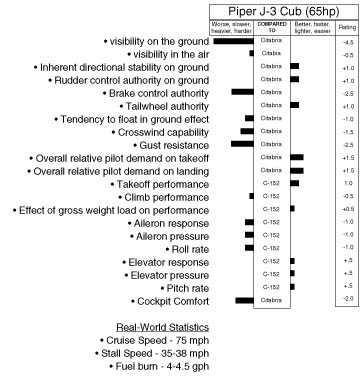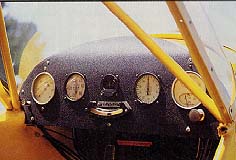

Flight Characteristics.
To fly the airplane, you have to get in it, which in a Cub,
isn't as easy as it sounds. You have to master the entry-dance.
Right foot in the step, lean forward over the front seat, left
foot past the stick, bring right foot in, lower yourself backwards.
There that wasn't so hard, was it? The canvas sling back seat
is much more comfortable than the front seat. Over-average height
folks will be folded like a pocket knife in the front seat.
If it's your first time in a Cub, you'll think you're sitting at an impossibly steep tail down angle. And you are. Few Classics have such a tail down stance, but the feeling of blindness is largely one of perception. Because the airplane is so narrow, only a small wedge is taken out of the visual field. Unfortunately, it's directly in front of you.
Contact! Brakes! Mags hot!. A good engine will catch on the first blade. If it's your first flight, close the door, as it causes some perceptual difficulties because, with it open, you can see so much better out of the right than the left.
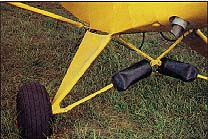 The first thing you'll notice
in maneuvering on the ramp is how hard the stupid heel brakes
are to get at because they're snuggled under the seat. That's
good. That way you won't be tempted to use them on landing where
they aren't needed.
The first thing you'll notice
in maneuvering on the ramp is how hard the stupid heel brakes
are to get at because they're snuggled under the seat. That's
good. That way you won't be tempted to use them on landing where
they aren't needed.
"S" turns are absolutely necessary to see ahead, but they also give you rudder practice. For some reason, maybe it's the light tail, the Cub is quicker to respond to the rudder than most light taildraggers, including the Citabria. It's only a minor difference but noticeable. On takeoff and landing it makes it a little easier than some to over-control.
By all means, do a full 360° turn to clear the pattern before taxiing onto the runway. The pilot sits so far back in the airplane vision is sharply limited by the narrow tunnel of the fuselage and the wings and a full turn is mandatory.
Lined up, suck the stick back and move the throttle smoothly forward. The noise turns into kind of a rattling roar and the airplane will begin accelerating at about the same rate as a heavily loaded Cessna 152. As soon as the power is full on, ease the stick smoothly forward and bring the tail up. If you're of average height you won't quite be able to see over the nose but the visibility improves drastically anyway. There is so much airplane between you and the outside world, there is no doubt when the nose tries to move.
The rudder becomes effective as soon as the power is on and you'll notice the tail moves each time your foot does. The airplane is very stable directionally. In fact, if there is no crosswind, the tail won't move sideways on its own. If it is, stop moving your feet for a second to see if it isn't you causing the movement.
Even on a calm day, the Cub will fly off the ground long before you can get in serious trouble. If there is just a few knots of wind on the nose, it'll leave the ground almost as soon as the tail is up. Solo it leaps off. Dual it takes much longer. The airplane really reacts to extra weight.
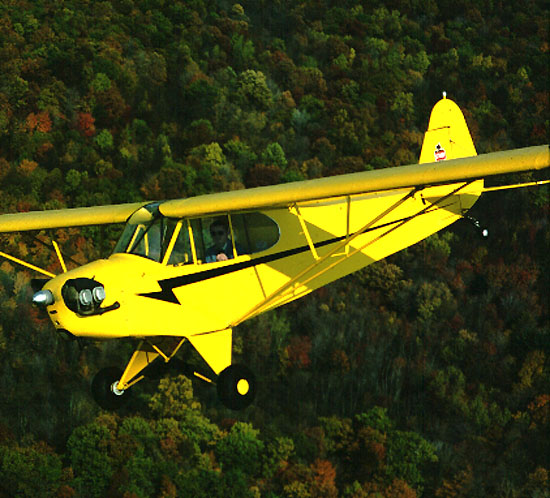
With one on board, a 65 hp Cub in 75 degree air may give as much as 400-500 fpm. 85 hp adds at least another 200 rpm and a C-90 makes you feel like you have a fly-weight tiger by the tail. The increased power is also very noticeable on takeoff acceleration.
As you level off and the speed rockets ahead (read that with a lot of sarcasm), be suspicious of any speed above 80 mph indicated. 75 mph is a pretty standard Cub cross-country speed.
The controls in a Cub set the standard for most of the long-wing Pipers to follow. There's a fair amount of system friction because everything is cable and pulley operated. These days the friction is almost always aggravated by at least one pulley that isn't turning. The friction helps build the perception that the aileron forces are heavy, but they really aren't. The airplane responds very much in proportion to the amount of stick put into it and will actually roll into a bank much faster than people expect, if they put their shoulder into it. The pressures are much lighter and the response higher than a Citabria, for instance. Compared to a C-152, they are about even, although it's hard to compare pressures between a stick and a yoke.
Elevator pressures and rates are matched to the ailerons and you won't even notice the rudder because it mixes in so naturally. And you will need rudder. The airplane has noticeably adverse yaw and the pilot who doesn't coordinate will polish the bottom of his jeans smooth. That's one of the things that makes it such a great trainer
Stalls in a Cub can be what you make them. Normally, they are soft and floppy with very little edge to them. Feeling goes out of the controls in such a noticeable fashion, as the stall approaches, your hand will tell you something is happening, if nothing else does. If you have the door open, the bottom half will begin to float up as the stall is approached. If you crowd the stick back hard or persist in an exaggerated nose-high attitude, it will pay-off, drop the nose and make you light in the seat.
Coming in to land, power back opposite the end of the runway, you risk a stretched muscle as you lean forward trying to get the carburetor heat on the right side wall by your foot. Crank, crank the elevator trim and the airplane will hold an approach speed of 60 mph by itself. It can fly the approach much slower, but there's no reason to.
The Cub is dirtier than most of its contemporaries so its glide slope is a little steeper. It comes down even faster than a Citabria or 152, but at such a slow speed, the pattern is still not super-tight or rushed. Also, there is no such thing as "too high" in a Cub, as it is one of the best slipping airplanes ever invented.
A secret for getting consistent, good landings: Break the glide just a little higher than you think you need to. If you fly it into ground effect expecting to burn off speed and three-point it, you'll almost certainly touch the mains before getting the tail down. For some reason, Cubs appear to have less ground effect than many airplanes.
The nice thing about a Cub landing is that it happens at a near-walk. Actual touch down is around 35 mph, so even if your technique is sloppy, everything is happening so slowly you have all day to set it straight. If you don't have much tailwheel time, try not to think about it. Get the airplane on more or less straight and it will roll more or less straight. Start fighting the rudders simply because it's a taildragger and you think you should be doing something, and it will do a slow motion dance. Best advice in landing a Cub is to make sure it is straight and not drifting and leave it alone after touch down. There's a reason for the saying "...lands easy as a Cub..."
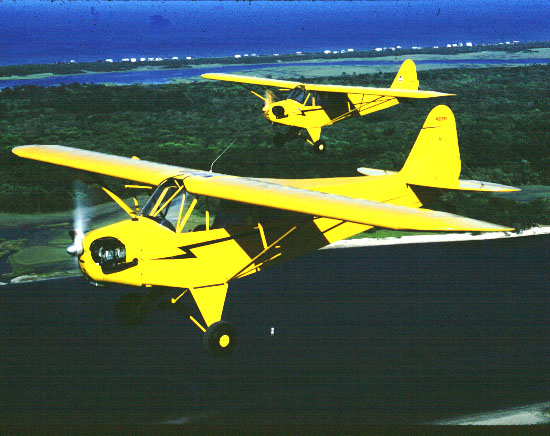
A word about crosswinds and gusts: The airplane is really lightly wing loaded and rides thermals and gusts like a cork. It will, however, handle much more crosswind than most think it will, providing the pilot has a firm hand and a good head. It can, however be overwhelmed. Winds which are an annoyance in a 152 are a challenge in a Cub. In a pinch, diagonal the runway, or turn into the wind at the end of roll-out. Then you have to worry about taxiing. It's entirely possible to land in a wind which is too high to taxi in. In that case, keep the nose into the wind and wait for help to walk you in. More than one pilot has had to coast past the hangars at fifty feet with the door open and the throttle back while yelling for help before landing.
One common J-3 variation seen, by the way, is the Reed Clipped Wing conversion which removes 40 1/2" from each wing root. To many, this makes a good airplane even better. Besides making it capable of loop, roll, spin, type of aerobatics, with 85 hp, it will cruise at nearly 90 mph and its entire handling package tightens up, becoming quicker and more crisp. It will also handle much more wind with the short wings.
Market forces almost always place a price premium on products which have proven themselves both in aesthetics and use. No where is this more obvious than in the J-3 Cub, as it is easily the most expensive airplane in its category. This is a distinction many believe to be well deserved.
